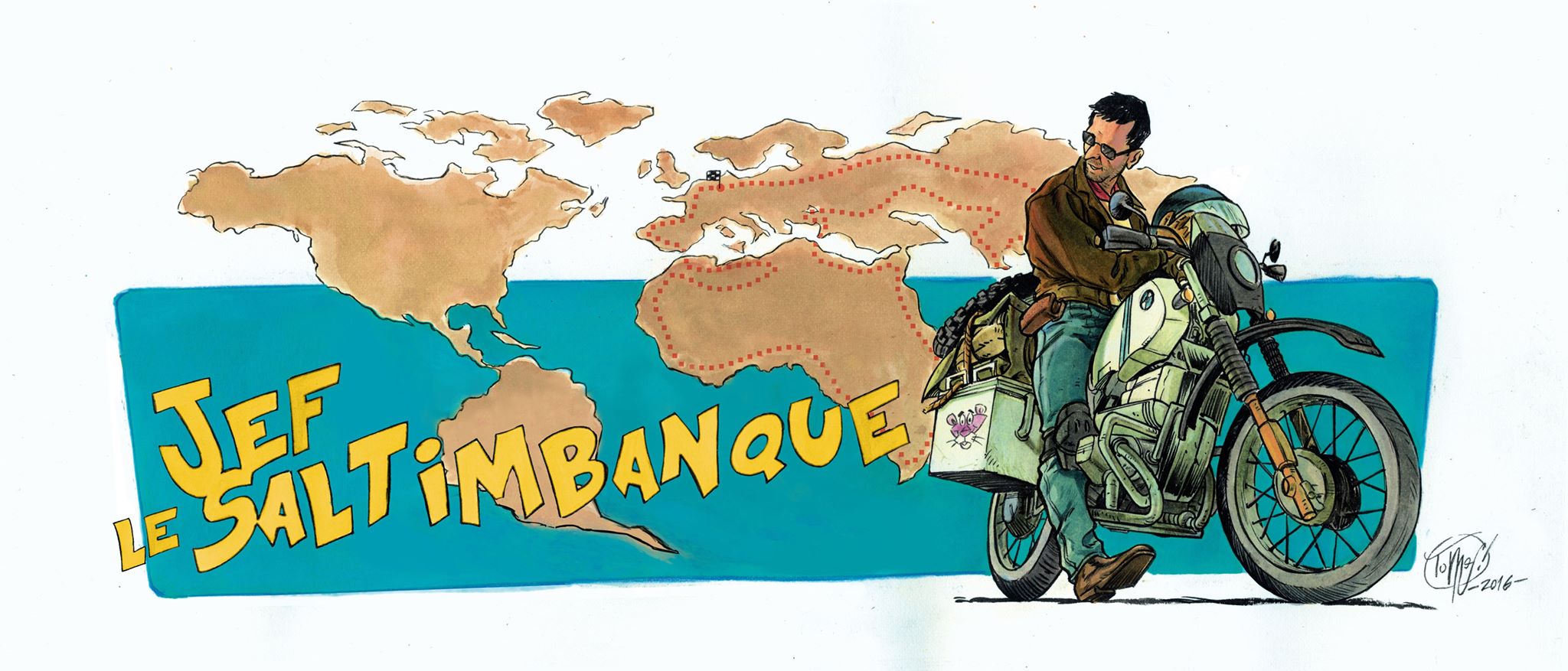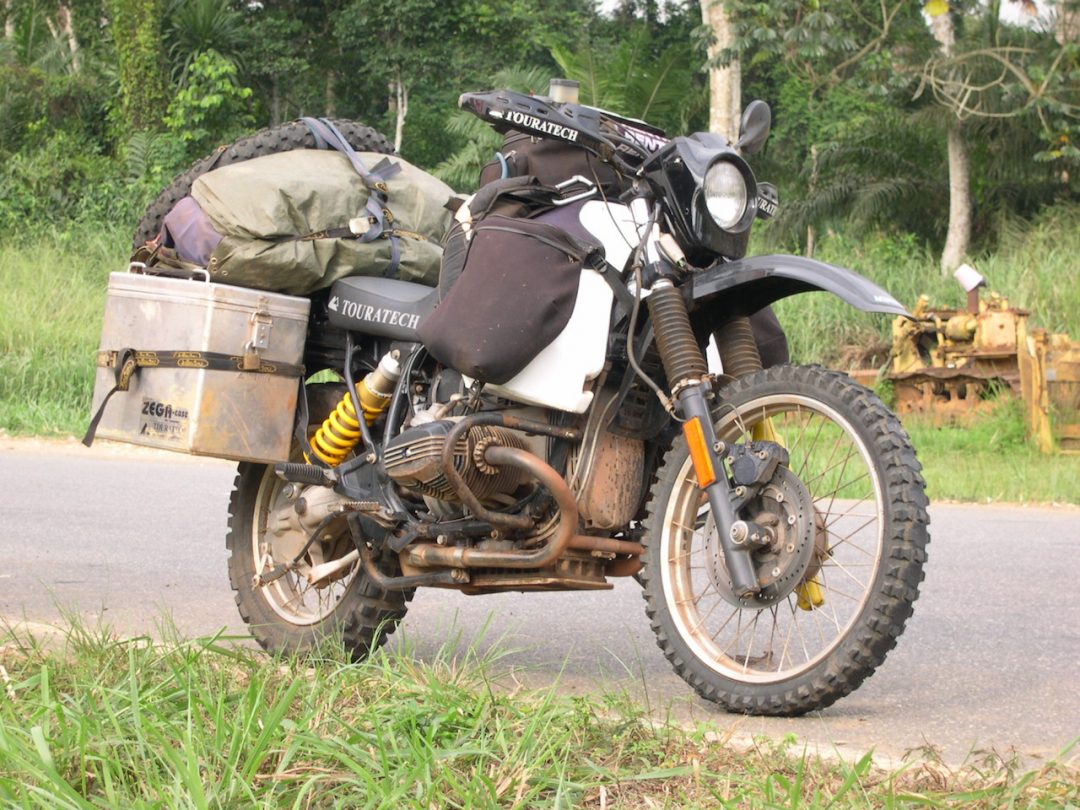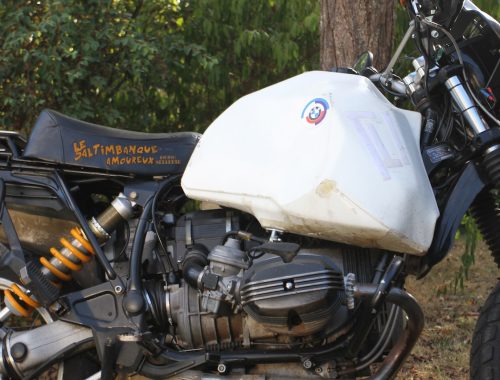Cet article est également disponible en : Français
The motorcycle is a BMW R 100 GS of 1991, which I bought for the African road trip of 2003.
At first I’d rather choose an R 80 GS but I could not find any with a low mileage at a reasonable price.
In fact, my initial choice was the Africa Twin or the R 80 GS, so the R100 was an imposed choice.
Anyway these motorcycles are all very heavy for long trips out of ordinary tracks and I must confess that I hesitated to ride it again for the next trip.
The weight is the main enemy for any trip, and for many reasons:
- Some tracks are so impracticable that riding alone with a heavy motorcycle is reckless, unless you weigh more than 100 kg and are a weightlifter
- A big and heavy motorcycle consumes much more gasoline and once the tank is filled the initial problem is amplified.
- The weight causes a faster wear of the tires, hardly replaceable in some parts of the world
So the rule should be to pack light. In my opinion a 250 would suffice for any trip.
Still, I decided to go back on the tracks with the same motorcycle, not always for objective reasons:
- It has a simple and reliable mechanic that I know now
- It is not too difficult to lift it for a man thanks to its cylinders
- I like driving it, although in certain circumstances I rant against its weight. I must say that the time has probably erased from my memory some hard periods it had made me live
- This bike is a real driving comfort as long as you don’t drive in the mud, and whatever the difficulties.
- In the end and above all, it’s totally irrational: I love this bike, I suffered with it and traveled with it. I am very attached to her “chugging” and it is my traveling companion … for better or worse.
Initial preparation (African trip 2003/2004)
For the curious, here are the main points of the preparation done for Africa:
- Complete mechanical overhaul of the bike and replacement of all wearing parts with new ones (including the clutch disc)
- Protection of the electric beam with a waterproof silicone sheath (to be sprayed on the beam)
- Change of original Seat by a single saddle seat.
- Change of front mudgard
- Move the oil cooler in order to protect it from possible falls
- Change of bottom of housing, aluminum one
- Wrist guards
- Welding of a larger plate on the basis of the side stand (in order to Jack up in soft ground)
- Wider feet rests
- Changing the tank for a bigger one – 45 liters (plus fuel filters)
- Reinforced shock absorbers
- Additional removable head light
- Cigarette lighter connected (in order to recharge electrical appliances)
- More powerful horn (siren)
- Changing the rear carrier in order to receive a gas can of 10 liters.
- Installing a new duplicate clutch cable duplicate “ready to assemble”
- Aluminum luggage and reinforced luggage track. The set of bolts provided by the supplier were replaced with larger diameter bolts.
- Tank bag with card holder
- “Washer” allowing to adapt all terrain tire at the back (specific to this bike)
After 16 months trip, the conclusion was as follows:
What was useless:
- The additional headlight, which broke in the early falls. (I have always respected the golden rule: never ride at night, even if the tent has to be pitched in unlikely places. This avoids express delivery of a rim by airplane … is not it Luc J
What was useful: everything but especially
- The waterproof protection of the electric beam. I have had no problems despite conditions of extreme humidity in the rainy season in the tropics.
- the plate on the side crutch
- Doubling the clutch cable. When it broke in Tanzania, 10 minutes were enough to trigger the new as it was pre-assembled.
What was missing or perfectible:
- The saddle, too hard, poorly shaped, painful after several months of travel.
- The air filter: original part, so I needed to have spare, not heavy but bulky.
- Horn: animals are totally insensitive to the sirens (however, very convenient to break through some very congested capitals :-)). It is necessary to have a horn like “trumpet”.
- No water reserve on the bike
- Aluminum luggage, too fragile, poorly contoured (luckily I had the ratchet straps to fix the bike, since the origins ties were literally torn off during successive falls).
- The seals of the pushrods should have been changed
- The clutch disc should be changed by a ceramic disc and not an original disc.
- Bearings (steering, swingarm) probably should have had been changed before departure
Mechanical problems during the trip (excluding breakage and standard wear of the parts – The bike was completely revised in CAPE TOWN SOUTH AFRICA):
- Steering bearings and swing arm
- Disc clutch (changed in South Africa. When I saw it I still don’t understand how I have ridden without problem)
- Shock absorber and gimbal (after about 40 000 km both broke down at about the same time)
- Tumbler stem seals
- The starter (replaced by a second hand Bosch in Ghana, more solid than the original Valéo which did not resist to the vibrations: polar masses, simply glued, were detached)
- Ignition wires
- Fork seal that broke down several times, I think because of a slightly veiled fork
What has never been a problem:
- The engine
- The frame and wheels
- The electric beam
Current preparation
Thanks to my experience, here is the preparing for the second trip. Basically it remains the same, I have just focused on a refurbishment of the bike done by CASTERA JEAN:
- Change all wearing parts and various oils
- New exhaust pipe
- Second hand front fork
- New brakes stirrups
- Aviation hose
- New side stand
- New housing guard
- Repackaged shock absorber
- Alternator refurbishment
- Carburators refurbishment
- Change of the carbons of starter
- Gasoline filter
- New hoses
- Reboring of the engine
- New timing chain
- Small turning lighting
- Bubble shield
- New saddle (in progress, it will be a separate article soon)
- New aluminium Luggage (the former is unrecoverable)
What have not been done for the previous trip::
- Washable and reusable air filter
- Aluminium handlebar
- Ceramic clutch disc
- Electric beam to be replaced
- Water tank attached behind the seat (this is in my opinion the best place: both protected from the sun and from the fall. Right now the reserves were fixed on the front but it does not suit me. Two reasons: too much weight on the front and too exposed to falls)
- Horn supercharged (I think I will fit a Goldwyn horn, I am seeking for a second hand one not too expensive)
- Replacement of the gearbox by a reconditioned model with Kick




No Comments